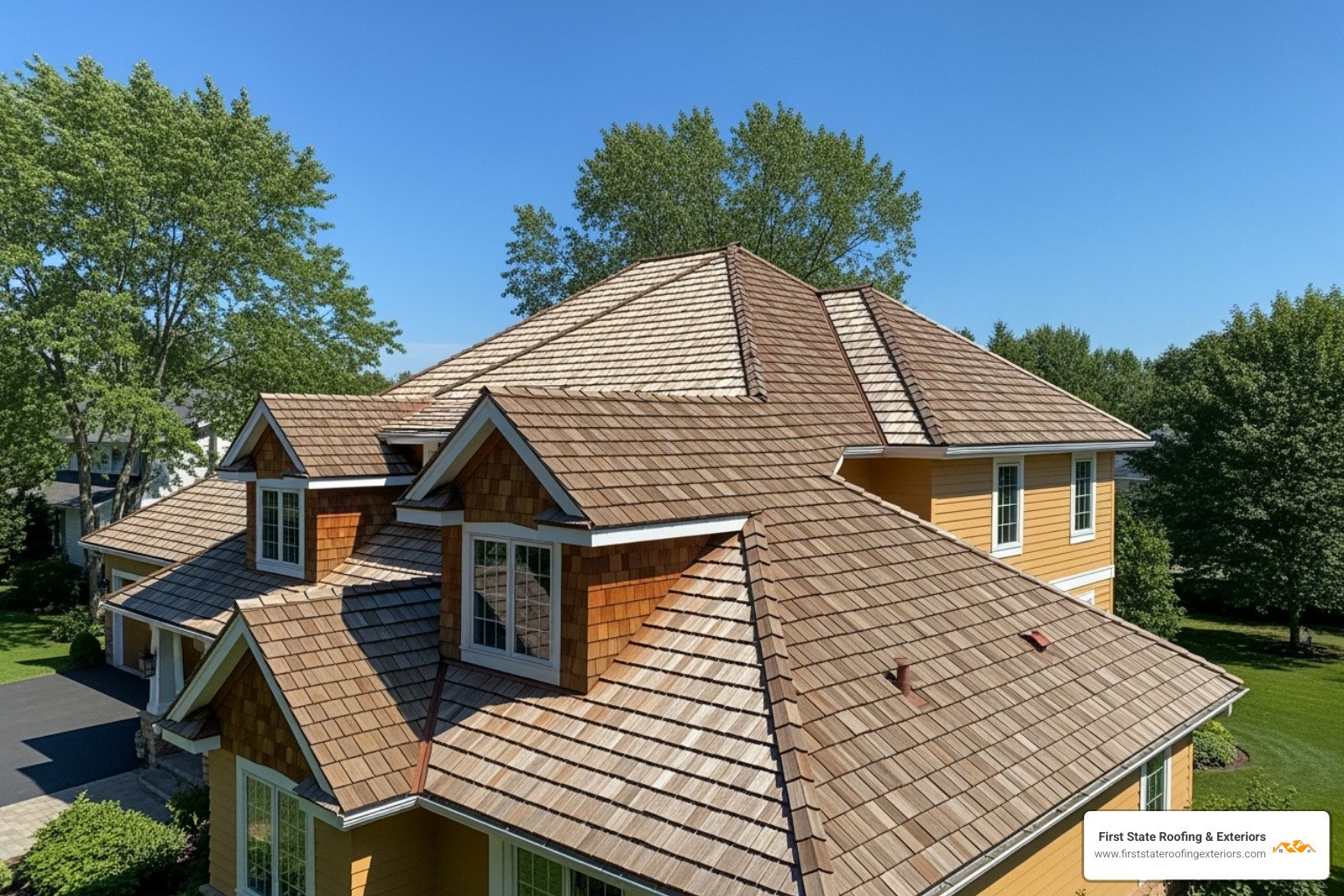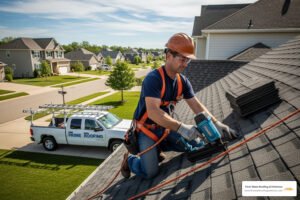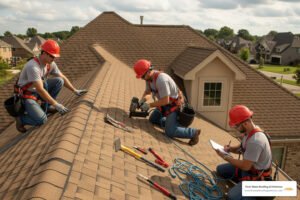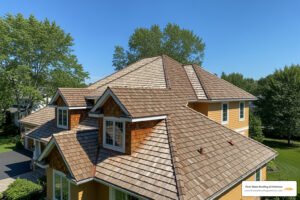Understanding Cedar Shake Roof Lifespan in Delaware’s Climate
For Delaware homeowners, the crucial question is, how long will a cedar shake roof last in Delaware? Many people even search for “how long will a cedar share roof last in Delaware,” but regardless of phrasing, the answer hinges on material quality, expert installation, and consistent maintenance in our humid climate. Cedar offers timeless natural beauty, and with the right approach your roof can last from 15 to over 50 years. Understanding these variables is key to protecting your investment. As First State Roofing & Exteriors, a trusted Delaware roofing contractor, we know that proactive care is the secret to maximizing your cedar roof’s longevity in the challenging First State climate.
Expected Lifespan:
- 30-50 years with proper installation and maintenance
- 15-25 years in Delaware’s humid climate without proper care
- Premium grade cedar can last up to 50 years or more
Key factors like Delaware’s high humidity, the quality of installation, and regular treatments determine whether a roof lasts for 15 years or 50. This guide will walk you through what you need to know to protect your investment.
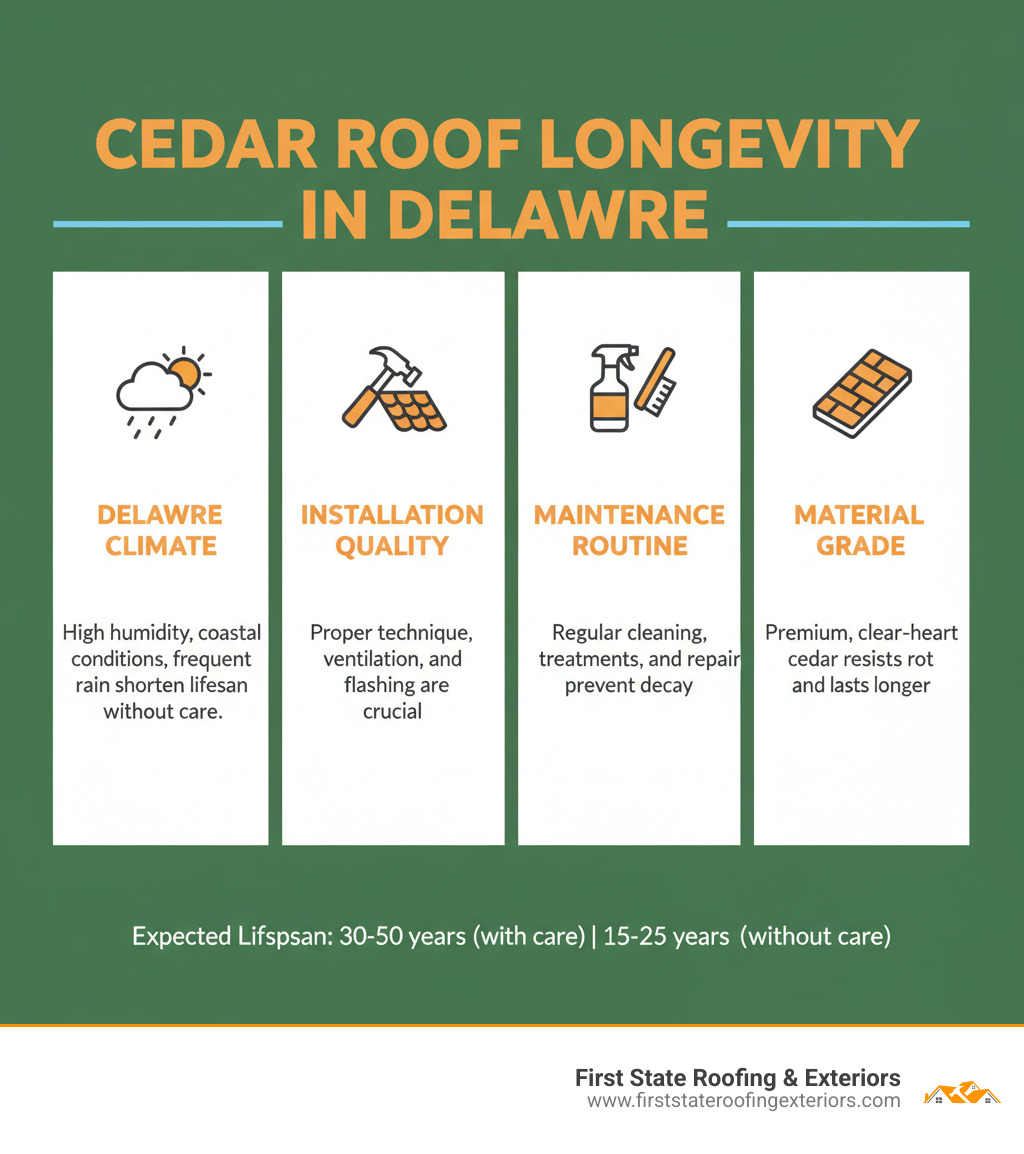
What Determines How Long a Cedar Shake Roof Will Last in Delaware?
While cedar roofs nationwide can last 30 to 50 years, the answer to how long will a cedar shake roof last in Delaware is more complex due to our unique climate. The lifespan of your roof is determined by an interplay of factors, including our local weather, installation quality, material grade, and maintenance routine. Understanding these elements is crucial, as they can mean the difference between a 15-year problem and a 50-year investment.
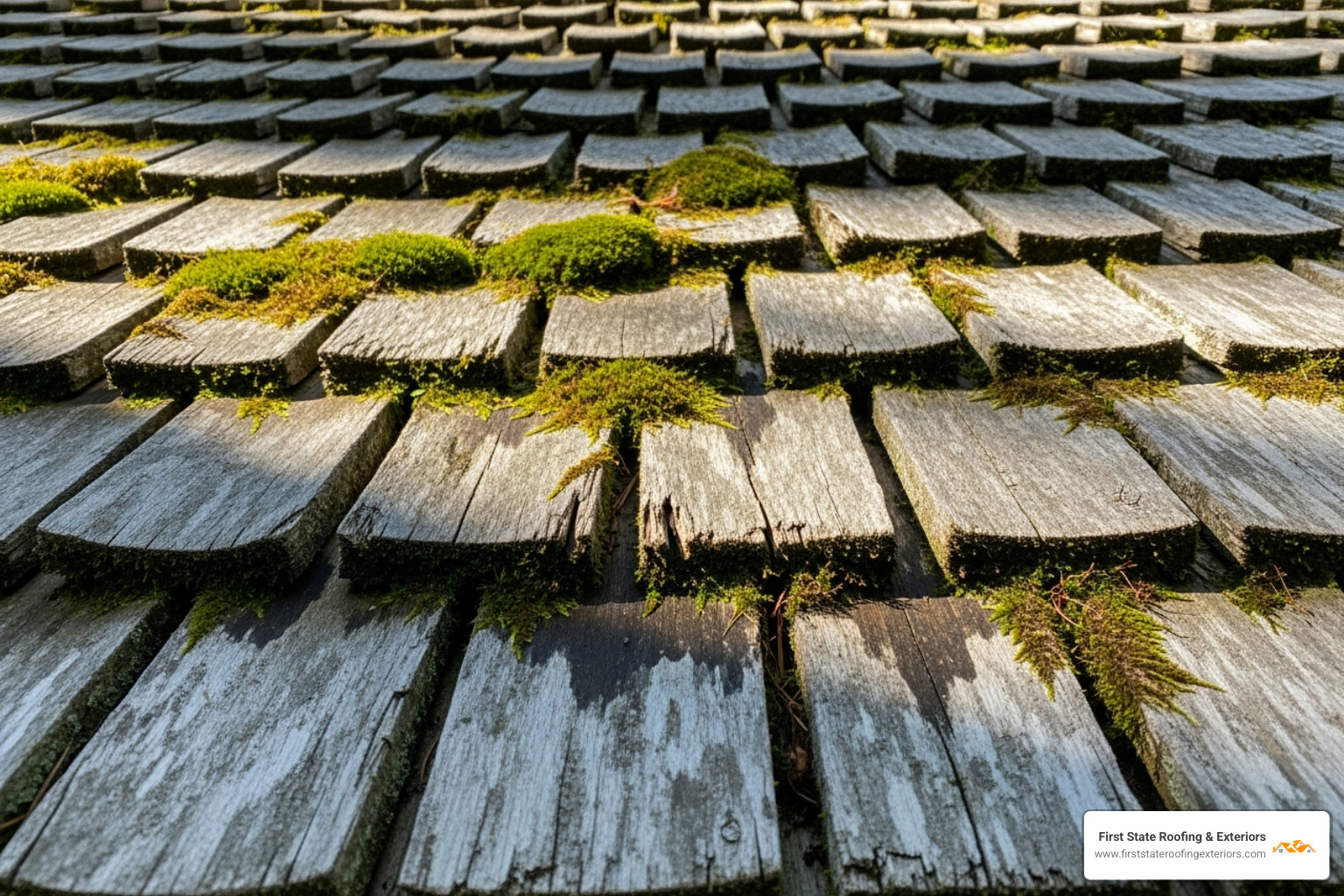
How Delaware’s Climate Impacts Cedar Shake Roof Longevity
Delaware’s humid subtropical climate is tough on natural wood. High humidity and frequent rainfall are the biggest challenges, as cedar shakes need time to dry completely. Prolonged dampness encourages moss and algae growth, which traps moisture against the wood, leading to warping, curling, and rot. For coastal homes, salt air can accelerate weathering. Additionally, our winter freeze-thaw cycles cause the wood to expand and contract, which can lead to cracking, while summer sun causes UV degradation that slowly weakens wood fibers.
Fortunately, cedar has a natural defense. Its natural resistance to rot comes from tannins and oils that repel insects and mold. However, even with this advantage, Delaware’s climate demands proper care. Learn more about maximizing these benefits through our Cedar Shake Roofing services.
Choosing the Right Cedar for a Long-Lasting Roof
Not all cedar is created equal, and your choice significantly impacts longevity. Western Red Cedar is the gold standard, offering superior durability and resistance to rot and insects. Eastern White Cedar is generally softer and more prone to cupping and splitting in our climate.
Shake quality, or grade, is also critical. The Cedar Shake & Shingle Bureau sets the standards:
- Premium Grade: 100% clear heartwood with no defects, offering the longest lifespan.
- Number 1 Grade: Allows for minimal imperfections and delivers excellent performance.
- Number 2 Grade: More economical but includes knots that can become weak points.
Finally, grain orientation matters. Edge grain shakes are stable and resist warping, while flat grain shakes are prone to cupping. For a durable roof, shakes should be at least 90% edge grain. Whether you choose rustic hand-split shakes or uniform tapersawn shakes, ensuring they meet grading standards from the Cedar Shake & Shingle Bureau is essential for a long-lasting roof in Delaware.
The Critical Role of Installation and Ventilation
Even the highest-quality cedar shakes will fail prematurely if not installed correctly. In our experience, most cedar roof failures stem from poor installation practices, not the material itself. Cedar shake installation requires specialized knowledge, and the difference between proper and improper work can determine how long will a cedar shake roof last in Delaware—sometimes cutting a 50-year roof’s life down to 20.
Investing in quality materials without expert installation undermines the entire project. The long-term performance benefits of professional craftsmanship are immeasurable, extending your roof’s life by decades and saving you from premature replacement costs.
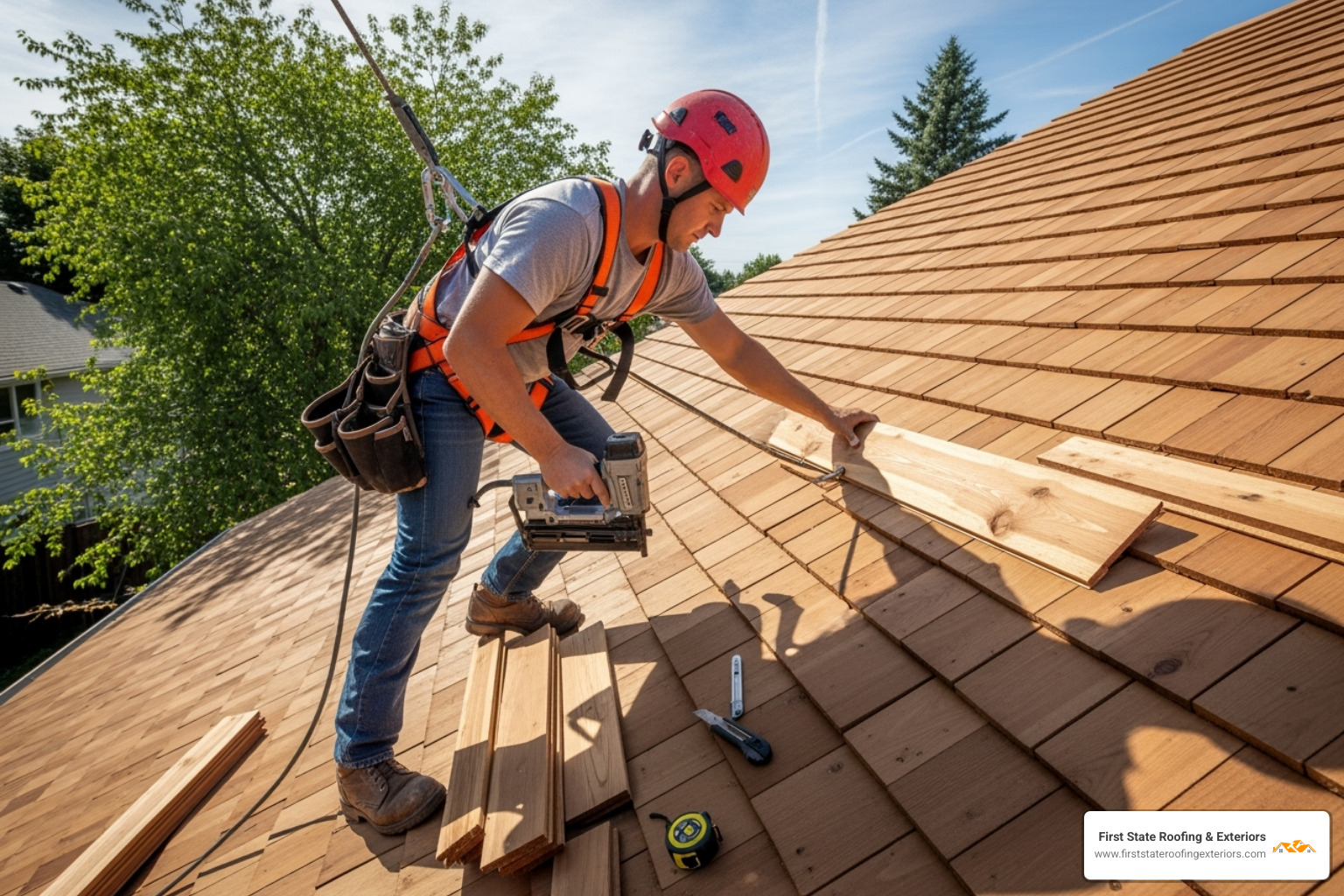
Why Professional Installation is Non-Negotiable
Every detail matters in a cedar shake installation. Proper techniques include using stainless steel ring-shank nails that are driven flush with the shake’s surface—never overdriven, which can cause splits. Nail placement is strategic, ensuring they are covered by the next course to protect them from weather. A key step is placing interlayment felt layers (#30 roofing felt) between each course to act as a secondary moisture barrier, which is vital in Delaware’s rainy climate.
Experience is also crucial for ensuring correct spacing (typically ¼-inch to ⅜-inch) between shakes to allow for natural expansion and contraction, preventing buckling. Finally, valley and flashing details must be perfect to prevent leaks, using materials like copper flashing and self-adhering membranes. To learn more about what quality work entails, our roof installation guide offers detailed insights.
The Importance of a “Breathing” Roof System
A cedar roof must be able to breathe to maximize its lifespan in Delaware’s humidity. When moisture is trapped underneath shakes, it creates ideal conditions for rot and mold. A healthy roof starts with adequate attic ventilation to regulate temperature and humidity, helping the underside of the shakes stay dry.
To further prevent moisture traps on modern solid roof decks, specialized underlayment ventilation products are essential. Products like Cedar Breather create a continuous air gap between the shakes and the roof deck. This small space allows for constant airflow, promoting rapid drying after rain and preventing the moisture buildup that leads to decay. We always recommend these ventilation products like Cedar Breather because they are a small investment that dramatically extends roof life by allowing the entire system to “breathe” properly.
Essential Maintenance to Maximize Your Roof’s Lifespan
Think of your cedar shake roof as a fine piece of outdoor furniture—it requires regular attention to stay beautiful and functional. The answer to how long will a cedar shake roof last in Delaware often comes down to consistent, proactive care. In our state’s humid and coastal climate, maintenance isn’t just recommended; protect your investment. A simple maintenance routine can be the difference between a 15-year roof and one that lasts for 40 years or more.
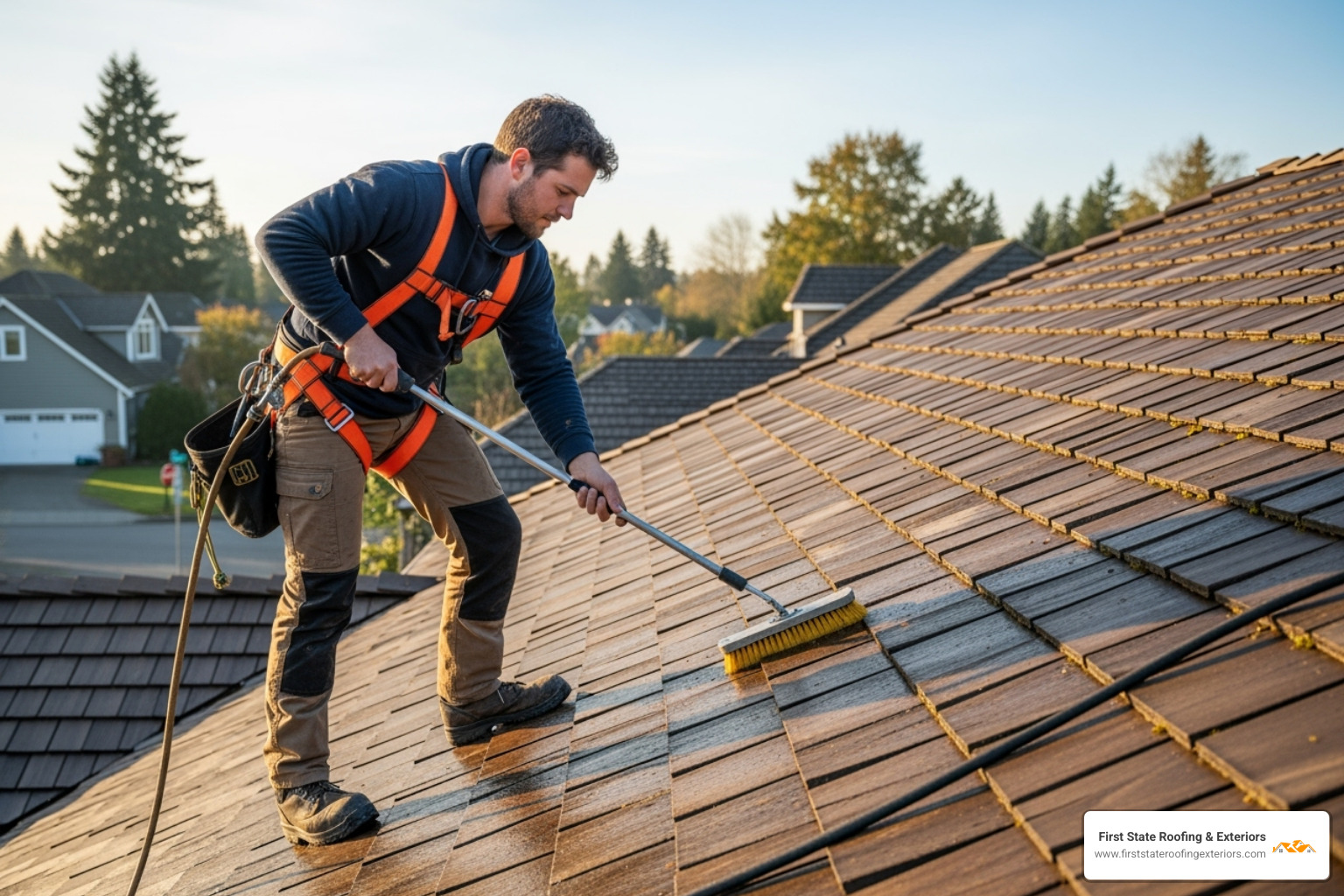
Your Annual Cedar Roof Maintenance Checklist
Regular observation is the foundation of a long-lasting cedar roof. Homeowners should perform visual inspections from the ground twice a year (spring and fall) and after major storms, using binoculars to look for cracked, curled, or missing shakes. Other key tasks include:
- Gutter and Valley Cleaning: Regularly clear leaves and branches that trap moisture and prevent shakes from drying.
- Gentle Debris Removal: Use a leaf blower to clear loose debris. Avoid harsh tools like rakes that can damage the wood.
- Trimming Overhanging Branches: Keep branches from touching the roof to prevent debris accumulation, excess shade, and physical damage during storms. Sunlight is a natural ally in keeping your roof dry.
Professional Cleaning and Treatments for Delaware’s Climate
While DIY checks are helpful, professional treatments are vital for addressing Delaware’s specific climate challenges. Professional soft washing is the correct method for cleaning cedar. Never use a high-pressure washer, as it can strip wood fibers and force water under the shakes, causing rot. Soft washing uses low-pressure and cedar-safe solutions to gently remove moss, algae, and dirt.
Fungicide and algaecide applications are also valuable, preventing the growth that thrives in our humidity. For long-term protection, UV-inhibiting sealants shield the wood from sun damage, while oil-based preservatives replenish the cedar’s natural protective oils that diminish over time. These professional treatments are a cost-effective investment that can add decades to your roof’s life. For more ideas on protecting your roof, explore our roofing tips for homeowners.
Recognizing When to Repair vs. Replace Your Cedar Roof
One of the toughest decisions for homeowners is whether to repair or replace a cedar shake roof. This choice greatly affects how long will a cedar shake roof last in Delaware and has significant financial implications. Fortunately, your roof provides warning signs long before a crisis. Learning to read these signals helps you make a cost-effective decision that protects your home’s integrity.
Key Warning Signs Your Cedar Roof Needs Attention
Be aware of these common indicators that your cedar roof needs professional assessment:
- Cracked or Split Shakes: Caused by UV exposure, freeze-thaw cycles, or impact. Widespread cracking suggests the roof is nearing the end of its life.
- Curling or Cupping Edges: A sign of moisture problems, this compromises the roof’s ability to shed water and may indicate ventilation issues.
- Missing Shakes or Ridge Caps: An urgent problem that exposes your roof deck to the elements and can lead to significant leaks if not repaired promptly.
- Widespread Moss or Fungus: While some growth is normal, thick moss traps moisture and accelerates decay, actively shortening your roof’s lifespan.
- Water Stains in Your Attic: A red flag for active leaks that require immediate professional intervention.
Making the Call: Repair or Full Replacement?
The decision to repair or replace depends on your roof’s age, the extent of the damage, and long-term costs.
The 30% rule is a helpful guideline: if less than 30% of your roof is damaged and it’s under 30 years old, targeted repairs are often the most sensible option. This applies to isolated issues like replacing a few cracked shakes or fixing a small leak.
However, age becomes the deciding factor as a roof approaches or exceeds 30 years. At this stage, the wood is naturally nearing the end of its lifespan, and extensive repairs can be a poor investment. If damage is widespread (systemic failure) rather than localized, replacement is usually the better long-term value, preventing escalating repair costs and potential interior damage.
| Factor | Repair Makes Sense | Replacement Recommended |
|---|---|---|
| Roof Age | Under 30 years with good overall condition | Over 30 years or nearing expected lifespan |
| Damage Extent | Less than 30% of total roof area affected | More than 30% damaged or widespread deterioration |
| Problem Type | Localized issues from specific causes | Systemic failure affecting multiple roof areas |
| Long-term Value | Cost-effective for isolated problems | Prevents escalating repair costs and interior damage |
How Cedar Shakes Compare to Other Delaware Roofing Options
When considering a roof replacement, it’s wise to compare all your options. Understanding how long will a cedar shake roof last in Delaware relative to other materials helps clarify its value. While cedar’s natural beauty is best, it’s important to see how it stacks up in longevity, maintenance, and cost.
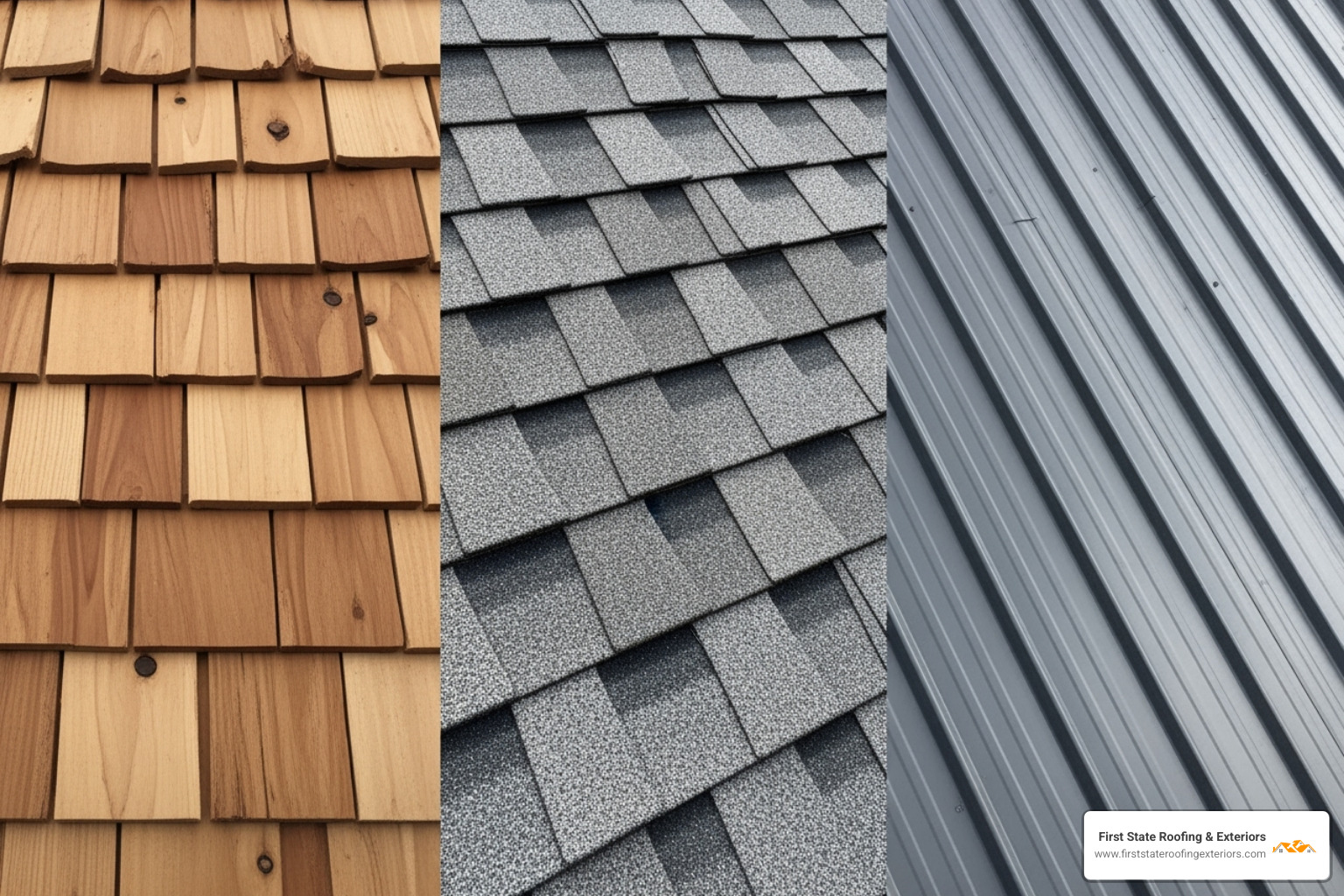
Lifespan and Maintenance Comparison
Here’s a look at what you can expect from different roofing materials in Delaware’s climate:
- Asphalt Shingles: The most common option, asphalt roofs typically last 20 to 25 years. They are budget-friendly upfront but require more frequent replacement.
- Metal Roofing: A durable choice lasting 40 to 70 years. Metal is low-maintenance and weather-resistant, though the initial investment is higher.
- Slate Roofing: The pinnacle of longevity, slate can last 100 to 200 years. It is beautiful and virtually indestructible but comes with a very high price tag.
- Cedar Shakes: With a lifespan of 30 to 50 years (with proper care), cedar offers a great balance of longevity and natural character. It requires more maintenance than metal or asphalt but provides a unique aesthetic that other materials can’t replicate.
For more details, Consumer Reports offers insights on different roofing shingles.
The Environmental Edge of Cedar Roofing
Beyond its beauty, cedar is an environmentally conscious choice. It is a renewable resource sourced from sustainably managed forests. Its natural insulation properties are impressive, providing up to twice the insulating value of asphalt shingles. This helps keep your home cooler in the summer and warmer in the winter, leading to energy efficiency benefits and lower utility bills.
From harvesting to disposal, cedar maintains a lower carbon footprint than manufactured materials. At the end of its long life, a cedar roof is completely biodegradable, returning to the earth without leaving a lasting environmental impact.
Frequently Asked Questions About Cedar Roof Longevity in Delaware
As homeowners consider cedar roofing, many have similar questions about performance in our coastal climate. Here are answers to the most common concerns regarding how long will a cedar shake roof last in Delaware.
How often should a cedar roof in Delaware be professionally inspected and treated?
Due to Delaware’s humidity, we recommend a professional inspection every 3 to 5 years, especially once the roof is over 8 years old. This allows a specialist to spot early signs of moss, algae, or moisture damage. Based on the findings, targeted treatments like preservatives or fungicides can be applied to protect the wood and extend its life. Between professional visits, homeowners should conduct their own visual checks after major storms.
Can I pressure wash my cedar roof to remove moss?
No. Never pressure wash a cedar roof. High-pressure water strips away the wood’s protective surface, can cause splits, and forces water underneath the shakes where it can cause rot. The correct method is professional soft washing, which uses low-pressure streams and cedar-safe cleaning solutions to effectively remove growth without damaging the wood.
Does a cedar roof increase my home’s value in Delaware?
Absolutely. A well-maintained cedar shake roof is a premium feature that significantly boosts curb appeal and property value. In a competitive real estate market like Delaware’s, its unique aesthetic, proven durability, and natural insulating properties make a home stand out. Buyers often see a cedar roof as a sign of a high-quality, well-cared-for home and are willing to pay a premium for it.
Conclusion
The question of how long will a cedar shake roof last in Delaware doesn’t have a single answer. Its lifespan is a story written over decades, shaped by the quality of the cedar, the expertise of the installation, and the consistency of your maintenance.
In Delaware’s humid climate, homeowners who understand these factors and commit to proactive care can see their roofs thrive for 40, 50, or even more years. The difference lies in the details: choosing premium materials, insisting on professional installation with proper ventilation, and following through with regular cleaning and treatments to combat moss and preserve the wood.
As a family-owned company rooted in Delaware, we at First State Roofing & Exteriors understand the significance of this investment in your home. We’ve helped families from Rehoboth to Dover protect their properties, and we’ve seen how quality care pays off. We are committed to helping our neighbors protect their homes with integrity and transparency.
We offer free estimates—call (302) 222-4065 to schedule a free inspection. Contact us today to schedule your free inspection and let us help you ensure your roof remains the crown jewel of your home for years to come.
